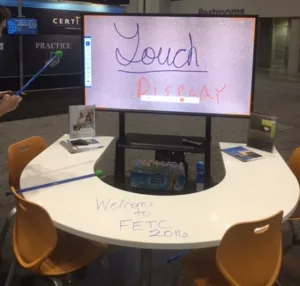The US ed tech conference season kicks off at the start of the year with a strong event, the Future of Education Technology Conference (FETC 2016), held each year in Orlando, Florida. FETC tends to set the tone and previews what’s coming for educational technology in the U.S.

Having spent considerable time crisscrossing the exhibit halls, as well as presenting at the conference, I would like to share some key observations related to the 3D presence and other display issues taking shape at FETC 2016. Below are my gleanings from the FETC event, now in its 36th year.
Trends
A STEM focus. The ed tech industry is clearly following the money trail. This year’s conference focused on STEM (science, technology, engineering, and mathematics). Both attendee sessions and the exhibit hall catered to the many U.S. schools now trying to create STEM magnet schools or in-school STEM programs to attract enrollment.
Part of the STEM focus at FETC
Pushing collaborative learning spaces. We are seeing a continued push toward the transformation of classroom learning spaces. Multiple sessions were offered on the topic of learning space design, and exhibitors showed their offerings in this arena. High-end display sales almost always accompany the collaborative learning space in schools. Notice the prominent role of display technology in the offered collaborative learning spaces shown below.
Down-sized exhibits. Several long-time attenders and exhibitors noticed the plethora of down-sized or co-located booths. (Except Promethean, which supersized its booth. [I suspect because of the acquisition last year by China-based NetDragon Websoft – Man. Ed.) And much less floor space was reserved in the exhibit hall. I spoke with some exhibitors who were prowling the floor but did not rent a booth because some teacher-centric conferences do not have enough decision makers in attendance. These observations worry me. But it may also be a result of new management/ownership for this conference.
Promethean went big and bold at FETC. Most others didn’t.
An uncomfortable sameness. Something really bothers me. I hope our display industry readers take it to heart. Basically, I notice a disturbing monotony—every booth exhibiting display technologies is exactly like every other display booth exhibiting display technologies. With the same hohum and unimaginative content on display. The same drab presentation, despite the underlying great technology. Successful products need differentiation, but my senses only capture ennui. Worrisome.
3D and VR in the Exhibit Hall
Overall, FETC evidenced the fewest 3D exhibitors in recent history. A few exceptions were noticeable.
Samsung. Samsung drew solid traffic to the back of their diminutive booth with the Samsung VR headgear.
Google. Google split their presence up, operating in various co-located booths, and drew some decent crowds to their Google Cardboard VR experience.
zSpace. zSpace drew nice traffic in two separate booths. They continue their marketing push to K-20, while changing much of their nomenclature to “virtual reality” as opposed to 3D.
Sensavis. This Swedish company was back in pursuit of educational customers with their 3D Classroom solution, this time featuring some new DNA content and future plans. (The subject of a later article.) Traffic was solid and steady, and attendees seemed to spend a lot of time evaluating this premium solution. Still, I think they would do even better if they changed their nomenclature from “3D” to the “virtual reality” meme as well.
Samsung VR Headgear drew crowds at FETC
zSpace at FETC
Fredrik Olofsson at the Sensavis booth, with a solid offering
3D and VR in the Conference Sessions
I not only attended this event, I also presented. My 3D workshop, “Trends in 3D Visualization for Education”, was well attended and well received, with even more people than last year. My poster session, presented on behalf of the ISTE 3D network, also saw a lot of traffic and interest. Two well-attended VR presentations by Hall Davidson of Discovery Education echoed some of the experiences he corralled at CES, but the presentations seemed mostly consumer- and gadget- oriented. And a two other sessions also briefly touched on the VR meme during the conference.
No, there’s no screeching acceleration yet for 3D or VR in education yet…just the hard work and heavy lifting of passionate advocates. – Len Scrogan

